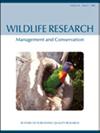野猪对橡子作为本地野生动物食物来源的影响
IF 1.6
3区 生物学
Q3 ECOLOGY
引用次数: 0
摘要
本文章由计算机程序翻译,如有差异,请以英文原文为准。
Impacts of wild pigs on acorn availability as a food source for native wildlife
ABSTRACT Context. Wild pigs (Sus scrofa) are a non-native invasive species that causes millions of dollars in damage each year to agriculture in the United States of America, destroys native plant communities, and competes with native wildlife for seasonally available pulse resources such as acorns. Despite many anecdotal observations and diet studies suggesting wild pigs reduce acorn availability for other wildlife species, no studies have comparatively examined acorn consumption among species in a natural environment (i.e. competition). Aims. Our objective was to estimate the consumption of acorns by wild pigs relative to that of other native wildlife species. Methods We established 40 monitoring stations beneath acorn-producing trees in a 3406-ha study area in eastern Alabama with an approximate density of 9 pigs/km2. At each monitoring station, we placed five acorns on a 1-m × 1-m sand pad and positioned a game camera to record acorn fate during 2-week intervals once a month from September to February 2018–2019 and 2019–2020. Cameras were set to capture images once every minute continuously during the survey period. Additionally, we constructed acorn traps from 18.9-L plastic buckets to estimate the timing and relative amounts of acorns that were potentially available for consumption at each monitoring station. Key results From approximately 7.3 million camera images, we observed 15 wildlife species consuming 707 acorns over the 2 years. Aside from animal consumption, acorn fate was categorised as lost due to flooding (n = 153), remaining on the sand pad at time of camera failure (n = 720), or not consumed during the sampling period (n = 536). Key conclusions Top acorn consumers were squirrel (Sciurus spp.), white-tailed deer (Odocoileus virginianus), raccoon (Procyon lotor), and wild pig. In the 2018–2019 sampling period, wild pigs consumption accounted for 23.4% (n = 87) of the total consumed acorns. After wild pig removal efforts were initiated in the summer and autumn of 2019, wild pigs consumed only 7.2% (n = 24) of consumed acorns. Implications Wild pigs consume a significant number of acorns and likely reduce the availability of this pulse resource for other native wildlife species and may potentially influence oak regeneration.
求助全文
通过发布文献求助,成功后即可免费获取论文全文。
去求助
来源期刊

Wildlife Research
生物-动物学
CiteScore
4.30
自引率
15.80%
发文量
56
审稿时长
3 months
期刊介绍:
Wildlife Research represents an international forum for the publication of research and debate on the ecology, management and conservation of wild animals in natural and modified habitats. The journal combines basic research in wildlife ecology with advances in science-based management practice. Subject areas include: applied ecology; conservation biology; ecosystem management; management of over-abundant, pest and invasive species; global change and wildlife management; diseases and their impacts on wildlife populations; human dimensions of management and conservation; assessing management outcomes; and the implications of wildlife research for policy development. Readers can expect a range of papers covering well-structured field studies, manipulative experiments, and analytical and modelling studies. All articles aim to improve the practice of wildlife management and contribute conceptual advances to our knowledge and understanding of wildlife ecology.
Wildlife Research is a vital resource for wildlife scientists, students and managers, applied ecologists, conservation biologists, environmental consultants and NGOs and government policy advisors.
Wildlife Research is published with the endorsement of the Commonwealth Scientific and Industrial Research Organisation (CSIRO) and the Australian Academy of Science.
 求助内容:
求助内容: 应助结果提醒方式:
应助结果提醒方式:


